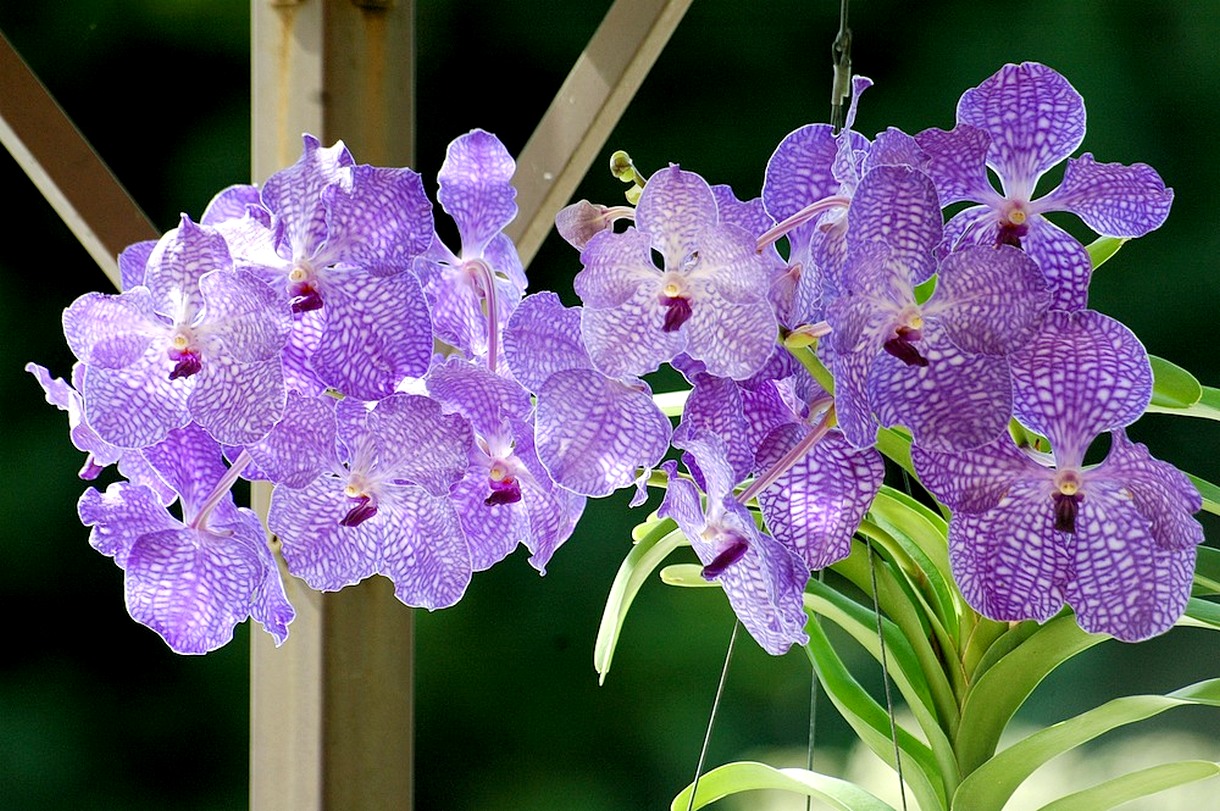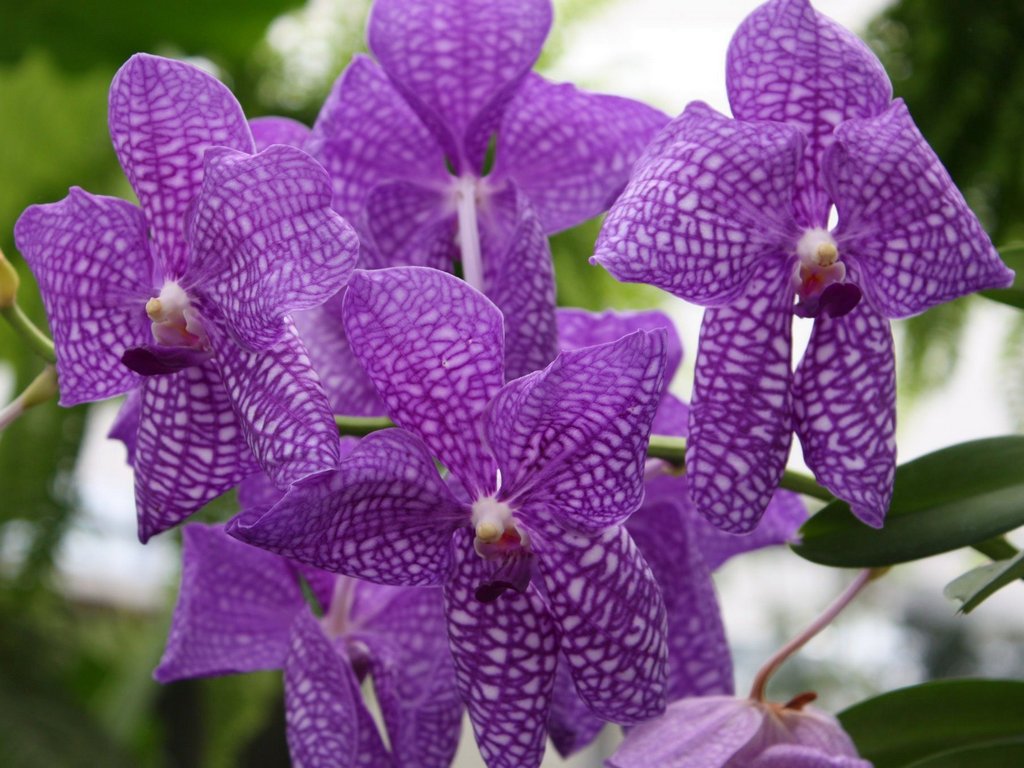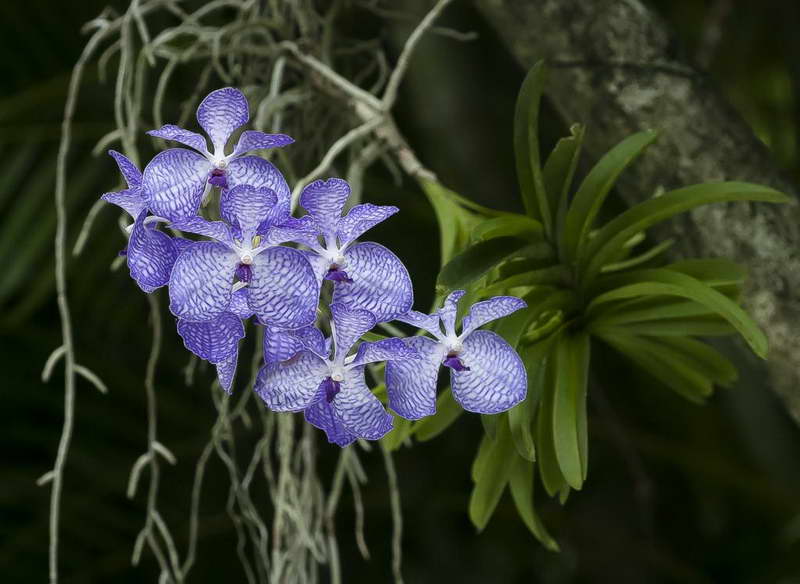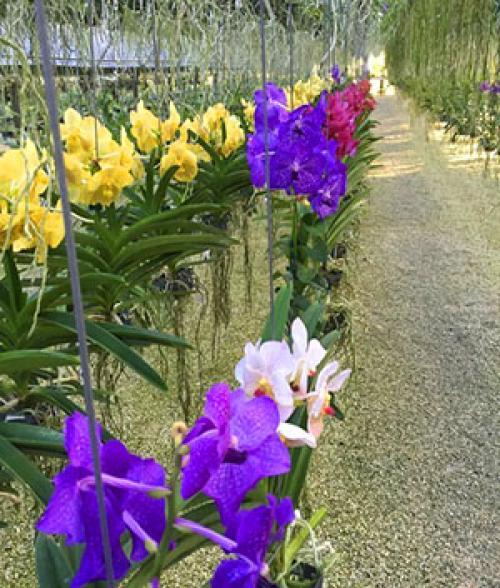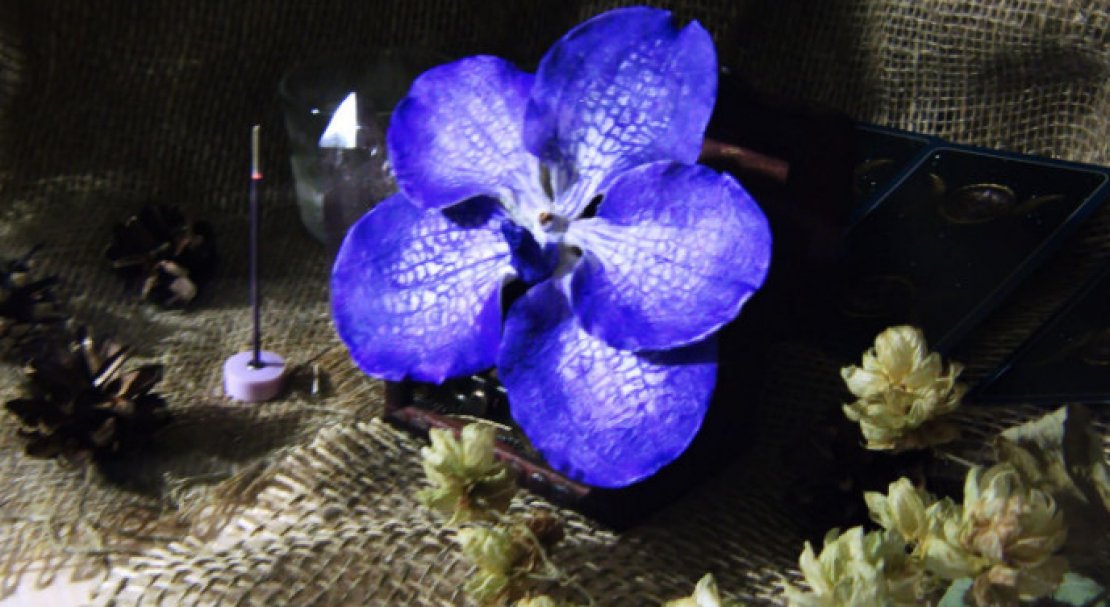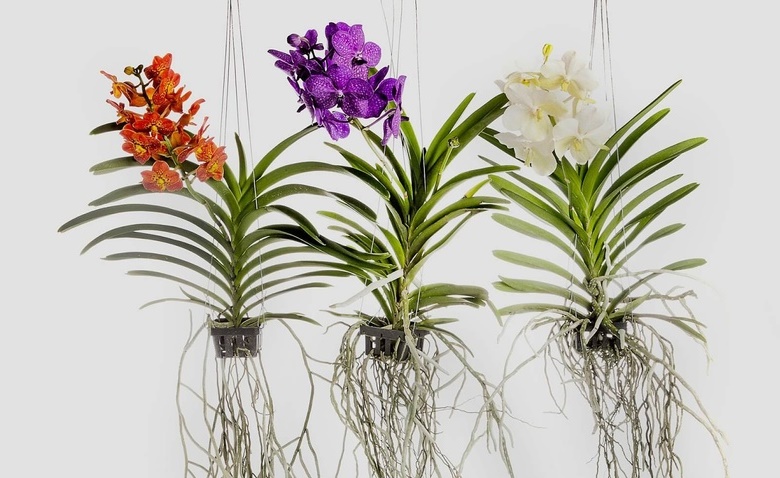Orchid Wanda - description of the species
The Wanda Orchid was first identified by a scientist named William Jones in Asia. The habitat of this beautiful flower is the tropics of Indonesia, South China, India, Thailand, the Philippines, and Northern Australia.
The height of the plant reaches a meter or more, the leaves are belt-like and leathery, are located on the stem alternately and die off during aging. Wanda is not characterized by the formation of pseudobulbs, since the flower does not grow in breadth, but only grows in height. Peduncles happen both straight and drooping, they can accommodate from 2 to 15 flowers, and the peduncles themselves in a flowerpot can be up to 4. Flowers in various representatives of the genus are monochromatic or multi-colored, reaching a diameter of 15 cm. The color of the petals can be of all kinds: white, yellow, blue, blue, purple, pink, red and brown. Not all orchids are endowed with a scent, but those that do have it, it is very fragrant. The orchid blooms up to one and a half months, and with appropriate care, this happens several times a year.
In addition to the incredible beauty of the flowers, a characteristic feature of Wanda is her roots, which are very powerful, their color is gray-green. The roots are covered with a dense layer of dead cells of a porous structure, which helps to protect them from sunlight and burns, as well as to absorb moisture well, even from the air.
The main varieties of Vanda orchids that are grown at home are: Comb, Blue, Great, Gentle, Sandera, Rochtilde.
Features of home care
In order for the Wanda orchid to grow and develop normally, care and cultivation at home must be carried out in accordance with certain rules.
Temperature
Vanda is a very thermophilic plant. When growing it in the middle lane, the plant needs to provide an air temperature in the range from 18 to 30 degrees. Moreover, at night it should not fall below +16.
Note! When growing an orchid of this variety at home, every florist should know that the higher the temperature in the room, the higher the humidity is required for the plant.
Lighting
Wanda is one of the most light-loving plants. In this case, you should not allow direct sunlight to fall on the flower. They can cause burns.
Regardless of the season, daylight hours should average about 12 hours. Diffused light is considered the most optimal for these plants.
Watering
In summer, the orchid needs to be watered once a day, and in winter, the number of waterings should be reduced to 1 time in 2-3 days.
It is strictly forbidden to allow stagnation of moisture near the root system.

Orchid genus Vendian variety Javier
Humidity
In the area of \ u200b \ u200bthe crown and leaves, it is recommended to maintain humidity within 70%. Only in this case can a significant acceleration of plant growth be observed.
Priming
Experienced growers recommend growing this kind of orchid with a bare root system. This is how the best air circulation is ensured. In addition, the plant will feel good in a substrate of crushed pine bark and various impurities.
Top dressing
Despite the fact that the Wanda orchid is very fond of feeding, fertilization should be applied only when the flower is in an active phase.
During this period of time, fertilizers must be applied with each watering.
Attention! Products that are specially designed for feeding orchids are ideal
A bit of history
 Nowadays, there are a large number of varieties and species of this plant and innumerable hybrids, which botanists-breeders replenish greenhouses with almost every day.
Nowadays, there are a large number of varieties and species of this plant and innumerable hybrids, which botanists-breeders replenish greenhouses with almost every day.
Over the past few decades, stems have been bred, which are distinguished by:
- The height of the plant itself;
- The diameter of the flowers;
- Flower color;
- Smell;
- The color of the leaves.
This flower captivated Europeans more than 200 years ago, but the difficulties with its cultivation did not allow orchids to spread freely throughout the continent.
And only after the phalaenopsis type hybrids were developed, the stem began to be grown not only in greenhouses and greenhouses, but also on the windowsills of their own dwellings.
Nowadays, in every flower shop you can buy a phalaenopsis orchid, but not all varieties are so widespread, there are varieties that require a lot of effort to find.
We will talk about these today.
Care

Caring for epiphytic orchids requires the attention of flower growers, otherwise the phalaenopsis may die.
Epiphytes with one growth point require special care, because if moisture gets into the core, rotting may begin and the stem will simply die.
Watering plays a very important role in the life of orchids, its abundance depends on the air temperature. The higher the thermometer readings, the more often and more abundantly orchids should be watered. In this case, it is advisable to use settled water.
Wanda is watered more often than other boles, bare roots dry out quickly. But there should be no stagnation of water near them.
It is worth feeding the plants according to the instructions, during the flowering period every two weeks, during the dormant period once a month. It is better to use a complex fertilizer, especially for epiphytes.
Wanda is fed by spraying the solution onto the root system, and then waiting for them to dry completely.
The temperature regime for boles is different:
- Wanda enough +25 during the day and +16 at night;
- Valencia prefers +27 during daylight hours and at least +20 at night;
- Whitney is enough +23 during the day and +15 at night.
Spraying from a spray bottle should always be present, it is carried out 3-4 times a week in the summer and a couple of times a month in the cold season. It is advisable to use not plain water, but with the addition of top dressing.
In addition, it is advisable to pamper phalaenopsis with a hot shower at least once every two weeks.
Breeding options
Reproduction of orchids of all varieties is considered a rather difficult process, especially if it is carried out at home.
If you provided the flower with proper home care, over time you will be able to propagate the culture with lateral shoots (Figure 7). Each of them must have its own root system, and the height of a viable shoot must be at least 5 cm. It is carefully separated from the mother plant and placed in a pot with a light and loose substrate, after sprinkling all the sections with charcoal powder. It is advisable to keep the seedling under cover, maintaining a high level of humidity.
Despite the fact that this method is very simple and effective, the house orchid rarely forms such offshoots at home. Therefore, if you need to grow a young plant, it is better to use the cuttings method.
 Figure 7. At home, a vegetative reproduction method is practiced
Figure 7. At home, a vegetative reproduction method is practiced
For this, the top of the stem with aerial roots is cut off from the mother plant and placed in a light substrate consisting of tree bark and sphagnum moss. In the first three days, the stalk is actively watered, and then grown at a reduced humidity level (watering is carried out more often 2 times a month).
Reproduction methods
Epiphyte reproduces with the help of offshoots (children) that form their own roots. It happens that a plant begins to grow a root system between the leaves.
By shoots
Reproduction by shoots:
- children with roots are cut off with a sterile, sharp knife;
- the cut area is carefully treated with charcoal;
- placed in a container with orchid soil;
- maintain the optimum temperature in the room: + 28 ° C and humidity 80%;
- watering the Wanda orchid 3-4 times a week;
- the plant is fed once every 14 days with a weak solution of phosphorus fertilizer - for the root system and nitrogen - for better growth and development of foliage.
- the flower should be transplanted to a permanent place in time.
It is advisable to separate the process 5–8 cm long.

Division of the stem
Division of the stem in the place of regrowth of roots:
- cut off with a sharp, sterile knife under the formed new root system;
- slices must be sprinkled with finely crushed charcoal;
- the upper part of the stem can be suspended or placed in a container for further growth;
- the lower part of the flower is left in the old place - new leaves will grow in a year;
- maintain a temperature regime of + 26 ... + 28 ° С, optimal humidity is also needed - about 80%;
- watered almost every day (up to five times a week) and sprayed;
- fed with phosphorus-nitrogen fertilizers every week.

Transfer
Experienced flower growers notice a wanda on the wall, in glass or in a pot. Do not transplant it when grown in a glass flask.

To do this, take a wide, but shallow plastic pot, in the walls of which holes are made. It is not necessary to buy a transparent container: the wanda needs more fresh air than sufficient lighting
Then a stick is carefully threaded through the holes for the stability of the plant, trying not to touch the roots. After that, sprinkle them with a substrate

Substrate growing has a drawback. The roots of a young flower quickly fill the pot. Therefore, from time to time it is necessary to change the old container to another larger one, making sure that there are no rotting areas on the roots.
In the cases listed below, the orchid is urgently transplanted:
- poor quality or poor substrate due to caking, lack of ventilation;
- contamination of the substrate and its unbalanced structure;
- deepening of roots;
- the appearance of rot.

Vanda orchid care at home

Location and lighting
Vanda orchid is a very light-loving plant. In addition to the fact that the place where the wanda will be located must be well lit, it must also have a constant flow of fresh air. For the location of the wanda, south-west or south windows are best suited. In spring and summer, wanda leaves need shading in the middle of the day from the scorching sun's rays. The duration of daylight hours for a wanda should be at least 12-15 hours, only in this case the plant will grow well and please with flowering all year round
In winter, with short daylight hours, it is important to use additional artificial lighting.
Temperature
The temperature of the content during the daytime in spring and summer should be about 20-25 degrees, at night - no higher than 17 degrees. In winter and autumn, the daytime temperature should not be 20-22 degrees, and at night - about 14 degrees. If the plant is kept in conditions where the difference between day and night temperatures is of the order of 8-10 degrees, then the vanda will bloom very soon. Conditions of detention are selected individually for each type of wanda. So blue varieties need a winter temperature of about 14 degrees.
Air humidity

Air humidity for keeping wanda must be at least 60-70%. Dryer air will cause the roots and leaves of the plant to dry out, and the buds may fall off without blooming. It is necessary to spray the orchid leaves every day with warm, settled water.
In winter, when the air from heating devices is too dry, in addition to spraying, additional methods of air humidification must be used (decorative fountains, containers with wet sand or expanded clay). But high air humidity must go along with good ventilation of the room, otherwise the plant may undergo fungal diseases.
Watering
In spring and summer, the vanda needs careful regular watering, but the roots must have time to dry out. The method of watering depends on the container in which the vanda is grown. If the plant is mounted in trellised baskets or on the bark of a tree, then water it by soaking the substrate in warm water for 20-30 minutes. You can also use warm rain
It is important to remember that water should not get on the leaves, otherwise they can quickly rot. The substrate between waterings must have time to dry out, otherwise the roots will begin to rot, which will lead to the death of the flower
In winter, the wanda is dormant, so it can do without watering for 5-7 days without problems. During this period, all metabolic processes in the plant are slowed down, so it does not need frequent watering. The water temperature for irrigation should be warm (30-50 degrees).
Top dressing and fertilizers

You need to fertilize the vanda with every watering throughout the year. To do this, use a universal fertilizer for orchids and dilute it in 1/8 of the concentration indicated in the instructions on the package. Root dressing can be alternated with foliar dressing by spraying the leaves. This will help avoid salinization of the plant's root system.
Content methods
At home, the optimal condition for keeping a wanda will be her suspended state. In this case, the roots should not be in the substrate. Both plastic pots and wicker baskets are used to attach the wanda.
Today, it is increasingly common to see the content of vanda in glass vases. In a vase, the vanda must be attached to a support, and the roots must hang freely. The bottom of the vase should contain a layer of wet sand or expanded clay, which will feed the plant with moisture. Almost half of the roots should be above the vase.
Vanda can also be successfully grown in a plastic pot with a substrate for other orchids, consisting of a mixture of pine bark, sphagnum moss and charcoal.
Features of reproduction and transplantation
The features of reproduction and transplantation need to be known to every grower. The need for a transplant occurs every two to three years. The plant does not need to be transplanted more often, and it is not worth touching it without the need, since the wanda, however, like any other orchid, reacts negatively to the disturbance of its tranquility. The need for a transplant is evidenced by:
- caked, dirty, damp substrate (it does not allow air to pass through, does not hold water well and dries for a long time);
- the presence of rot on the root system;
- excessive deepening of the root system into the ground;
- the plant does not fit in the pot.

If you notice any of these factors, it's time to start your transplant. You need to prepare fresh substrate and a new larger pot. Then proceed like this:
- Remove the plant carefully from the pot.
- Immerse the root system in warm (4-5 degrees warmer than room) water and soak for twenty minutes.
- Remove any remaining substrate and inspect the roots. If you see rotten or dried roots, they need to be cut off, the cut sites should be treated with ground cinnamon or crushed activated carbon and dried.
- Next, take a pot and cover the bottom with a drainage layer two centimeters thick (expanded clay is great), then pour in some bark and install a wand. Holding it with your hand, sprinkle with the remaining substrate, but not tightly so that the roots can breathe. Sphagnum moss is laid on top.
- You can water the plant two to three days after transplanting.
Reproduction of the wanda is carried out by transplanting her children. They can form in any part of the plant, but for this variety is characteristic appearance on the roots. It is necessary to separate the children only after the length of the roots has reached at least five centimeters. The baby is cut off with a disinfected sharp knife, and the cut points are treated with ground charcoal, which helps to avoid infection.

The baby needs to be planted in a separate pot with a small amount of substrate. Moreover, the ratio of tree bark and sphagnum moss should be 4: 1, respectively
It is important to maintain a temperature of 26-27 degrees and a humidity of about 90% until the roots grow up to 20 centimeters in length. It is most convenient to do this in a greenhouse.
Next, the baby is transplanted into an ordinary pot and looked after as an adult plant.
All other breeding methods are not available for the wanda. Some growers strive to grow an orchid from a seed, but this is quite difficult and time-consuming. In particular, greenhouse conditions will be needed (the temperature is about 28-29 degrees constantly, the humidity is above 90% and the illumination is at least 12-15 hours a day). You will have to wait for the sprout to appear from the seed for at least nine months. Further, the shoot will grow for three years, and only then it can be transplanted. Before the first flowers appear, you will have to wait another four to ten years, even if you know all the secrets of keeping and caring for an orchid.
3. Varieties:
3.1 Vanda blue or cerulea - Vanda coerulea
Blooming perennial, most common in indoor culture. It is a monopodial orchid with a single erect shoot, on which there are numerous green, thick leaves. During flowering, it forms attractive flowers with 5 rounded buds. By their appearance, the flowers resemble a violet and can be painted in a blue, blue, purple hue. Often there are white or dark specks on the surface of the petals. Each peduncle is capable of carrying 20 - 30 flowers.

3.2 Vanda tricolor - Vanda tricolor
A fast growing epiphytic orchid of impressive size. The leaves are long, belt-shaped, arcuate - curved, fleshy, green. Each flower stalk is capable of bearing up to 15 flowers, each of which reaches 7 cm in diameter. During the flowering period, the orchid emits an attractive aroma. The flowers are painted in white - pink or white - purple shades, the petals have small specks on the surface. The pharynx is often yellow.

3.3 Vanda Sandera
Plants, which are large in size, can reach a height of 80 - 120 cm. The flower has long, green, slightly curved leaf blades with a central vein recessed into their surface. Peduncles can bear up to 5 flowers in petals, painted in 2 - 3 different shades. Flower shades can include pink, orange, brown, burgundy, white, and yellow. The upper petals are lighter in color and solid, while the lower ones are dark and often speckled.

3.4 Vanda Vanda - Vanda teres
Plants are rare enough at home. The stems of this variety are often branched. Leaves are tough, narrow, dark green. Peduncles bear only up to 4 flowers each, but these flowers are distinguished by their impressive size and bright color of the petals. Shades of each bud can include 2 - 3 different colors. The edges of the petals are often corrugated, the diameter of the flowers can reach 6 cm. It is interesting that the lateral petals of the flowers are often inverted.

3.5 Vanda Rothschildiana
A hybrid of wanda blue and wanda valky. The main distinguishing feature of the flower is its cold resistance - asthenia can easily withstand a short-term drop in temperature to 10 C. The leaves are green, rather wide, easily bent along the central vein. The flowers reach 5 - 6 cm in diameter, each peduncle bears up to 5 - 7 flowers with rounded petals.

You may also be interested in:
How to grow the roots of the Wanda orchid
With improper care, the wanda loses its roots, and everyone needs to know how to grow them.
Often, with improper care, the Vanda orchid loses some of its roots. In order to grow new roots, you need to remove the plant from the pot, rinse the root system with a fungicide solution at a temperature of about thirty degrees and dry it. Then you need to remove all damaged roots and place the plant in a growth stimulant solution for ten minutes.
Taking a transparent pot, you need to fill it by one third with expanded clay and slightly moisten it. Wet sphagnum moss is laid on top of the drainage layer, in the center of which a depression is made, into which the prepared orchid will be placed and covered with moss on top.The container with the plant is placed in a warm and well-ventilated area. You can only moisten the planting by spraying around the edge of the pot. Under favorable conditions, the roots are formed a month after planting.
Wanda orchid growing methods
The plant leads an epiphytic lifestyle, it can be grown in three ways:
Using a substrate - growing in a pot

Growing wanda orchids in a pot with a substrate photo
Get a plastic pot that is loose enough so that the roots are not crowded. It is desirable that the container is transparent. Make lots of holes for ventilation. Orchid growing medium can be purchased at a flower shop or you can make your own. To do this, take 2 parts of pine bark, 1 part each of perlite and foam chips, ½ part of peat, add pieces of charcoal.
Growing Wanda Orchids in a Glass Vase

Vanda orchid how to care at home photo
You will need a stable, but not too tall vase or flask. Only the rhizome should fit into the container, and the green part should be outside (the plant needs bright lighting, and the glass delays the access of sunlight, plus there is a risk of leaf rot). The shape of the vase can be varied: oblong, spherical, goblet, etc. It looks very impressive, the Wanda Orchid in a glass vessel is a chic gift idea.
Watering Wanda in a glass vase is very simple: carefully pour water along the walls so that the roots are in the water, and after half an hour, gently tilt the vase and drain all the water, be sure to make sure that no moisture remains. In the summer, in the heat, it is watered like this 2 times a week, on cool days, one watering per week is enough
This method of cultivation has its drawbacks: the glass gradually becomes cloudy and dirty, the vase needs to be constantly washed, it is inconvenient to get the orchid, especially if the roots are tightly "adhered" to the wall of the vase and are damaged when trying to remove them.
Tips for growing a Wanda orchid in a glass vase
Growing in a glass vase, Vanda Orchid is a stylish interior decoration.
Take care of the comfort of the plant:
- choose a container with a wide base;
- the plant will live longer if the green part is outside the glass container;
- when growing in a glass container, the substrate is not needed;
- keep the roots dry in a container. To water or feed the plant, it is better to remove the orchid, immerse it in plain water or fertilizer solution, let the water drain well and dry the roots, then return it to the vase. This method is better because the vase stays clean and is easier to clean than if you water the plant in a vase and then drain the water.
Growing Wanda Orchids in Hanging Baskets with Bare Root System
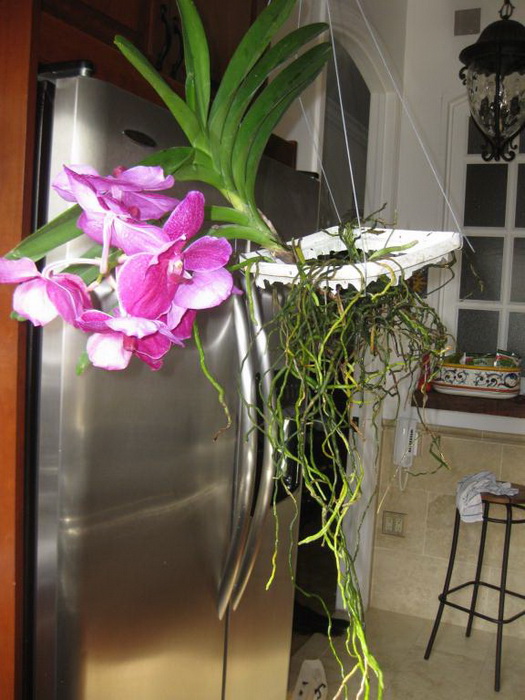
Growing vanda orchids with an open root system photo
You can grow Vanda in hanging baskets or pots with large side holes through which the roots will freely penetrate outward. Such plants are watered under a warm shower, letting them dry out and thoroughly blotting excess water in the leaf axils. Irrigation can be replaced with conventional spraying from a spray gun. On hot days, you need to spray it daily, on cool days - once every 2-4 days.
Orchid Vanda blue, blue, tricolor, purple and mini (with photo)
The genus Wanda includes more than 50 species of orchids that are found in the wild in the tropics of India, Indonesia, the Philippines, southern China and northern Australia. In culture, there is a huge number of interspecific and interspecific hybrids, since Wandas easily interbreed both within the genus and with orchids of other genera. Now the development of selection is aimed at obtaining miniature forms.
Most of the genus are rather large plants with leafy shoots reaching a meter or more. These plants are characterized by a monopodial structure, that is, they have a constantly increasing vertical axis of the shoot.All types of Wanda orchids are predominantly epiphytes, but they can also be lithophytes, that is, grow on rocky places and rocks. They have numerous aerial roots, which are covered with a thick layer of velamen and have the ability to absorb moisture even from the air. This tissue not only protects the root from sunburn and drying out in the air, but also, by retaining some moisture, helps the roots to survive the period of drought.


Wanda Rothschild is one of the few blue orchids in existence. This beauty grows well and blooms in a warm greenhouse with sufficient lighting. This blue Wanda orchid needs high humidity.
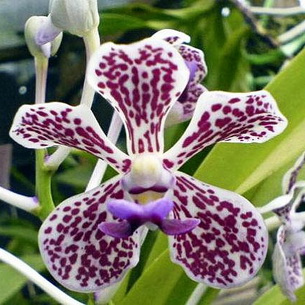

Wanda tricolor, or tricolor, is striking in its perfection. Its slightly falling inflorescences consist of 10-12 large, fragrant flowers. The homeland of this amazing orchid is Indonesia, Philippines. Tricolor Wanda can also be grown in glass vases.
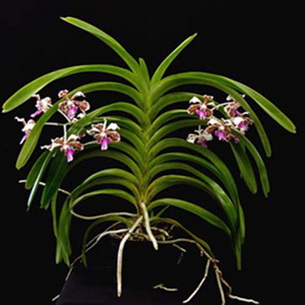

One of the interesting varieties of this species is Vanda suavis. It is a high-growing and profusely flowering orchid that requires moderate to high temperatures for its well-being.


Vanda blue orchid is native to Southeast Asia. Currently found in nature in northwestern India, northern Thailand, Myanmar and in the southwestern part of the Chinese province of Yunnan. An epiphyte that grows in sparse tree crowns, in forests and along river banks.
The most beautiful and widespread species, often used for hybridization. The height of the stem sometimes reaches 1.5 m. The leaves are dense, 20-25 cm long. Peduncles 50-60 cm long, bear multi-flowered inflorescences consisting of fragrant flowers 8-10 cm in diameter. The petals and sepals are blue, the lip is dark blue.


Vanda mini orchid are beautiful flowers, a large number of varieties form this specific group. They have more flowers on the peduncle than on ordinary species. The shape of the flower is symmetrical, with the same petals and the classic color characteristic of this type of plant.
There is also a special type of mini orchid - dwarf. They are actually very small - the foliage span is up to 20 cm, the flowers are about 3 cm in diameter. The main feature of mini orchids: standard orchid flowers, but much smaller in size than their counterparts.


Orchid Vanda purple - large, spherical flowers attract with their unusual bright color. The leaf span is on average 60-70 cm, sometimes up to 1 m. The leaves are belt-shaped, 40 cm long.
Look at the photo - the purple Vanda orchid has flowers with a white border and a yellowish-red lip, 10-12 cm in diameter, collected in straight, apical inflorescences, up to 10 flowers:

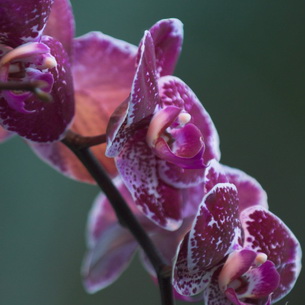
In nature, flowering occurs in autumn, but in culture it blooms in spring.
Distribution: From Sri Lanka to New Guinea, India - regions with a monsoon climate, as well as tropical Australia.
Popular types and hybrids of Wanda's orchid photo and description
The hybrids obtained in breeding have the general name Vanda × hybrida and differ in a variety of varieties with large or numerous small flowers of white, green, yellow-brown, red, purple, cherry or lemon shades, monochromatic or with a spectacular pattern.
Vanda blue (V. coerulea) is one of the few botanical orchids that can produce varieties with blue flowers - a property that is highly valued in the production of interspecific and interspecific hybrids.
In 1999, the Vanda Pachara Delight hybrid was registered, created from V. Coerulea and Vanda Gordon Dillon and received an FCC / JOGA award (First Class Certificate from the Japan Orchid Growers Association).
A rare feature of this hybrid form is its deep indigo blue color, which is quite rare in the orchid world, even among hybrids.
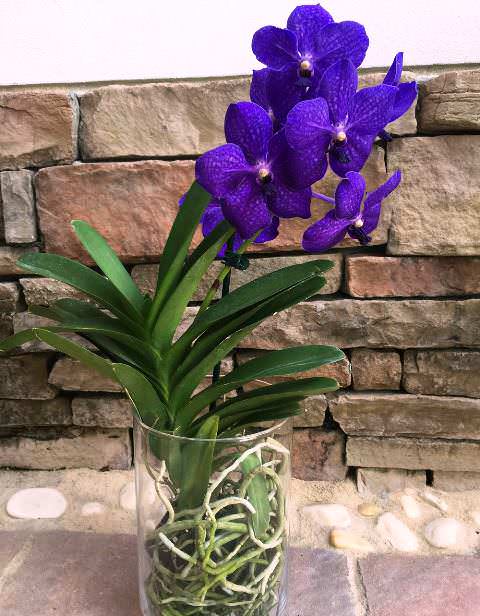
Vanda Pachara Delight Hybrid
Vanda dearei from Borneo is one of the main sources of yellow in the hybrid forms of this genus. Her graceful hybrid Miss Joaquim is the national flower of Singapore.
Wanda Sander (V.Sanderiana) and one of its amazing varieties "Alba", which is very popular with orchid growers for its unusual light green color.
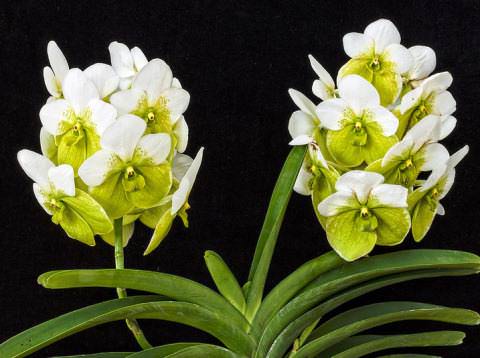
V. Sanderiana cultivar Alba
Vanda tricolor (Vanda tricolor) with curved reed petals and often wavy edges. A characteristic feature is an interesting speckled pattern of different shades on a monochromatic background of petals. The flower stem of the epiphyte can reach a height of about one meter.
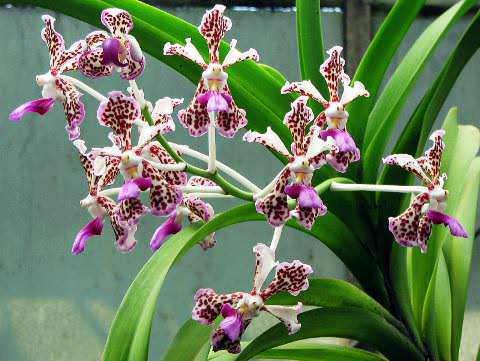
Orchid species Wanda
Of course, Wanda is not a plant that exists in a single copy, and therefore, before rushing to buy it, you need to think carefully and choose exactly the type that suits you. In order to help you with the choice, we have selected the three highest quality and most popular types of Wanda, and the first of them:
Wanda roll

This species is characterized by a rather long, branched stem, which, with proper care, can reach up to three meters in height. Also, this species of Wanda has a rather large root system. Volkovy leaves, in honor of which this species was named. They reach a length of about twenty centimeters, but they are quite thin - only three millimeters thick. However, of course, you are interested in flowers, not leaves. So, there are from three to six pieces of them on each peduncle, and each of them reaches up to ten centimeters in diameter.
Especially flowers of this species attract the eye with their color. He is incredibly beautiful and unusual. The central and outer petals of this Wanda are painted in different colors: on the outside there are pale pink petals with purple tints, but in the center is the scarlet lip of the flower, on which you can find both yellow and pink shades. Also, from one edge to the other, there are dotted stripes of scarlet color.
This type of Wanda orchid blooms in October.
Orchid Vanda blue

Blue Wanda Orchid: photo
The Vanda blue orchid is slightly smaller than the previous one, and the stem of this Vanda reaches no more than a meter in height. It also has a fairly large root system. Its leaves have a belt-like (ribbon) shape, and sharp teeth are located at their edges. This species has racemose inflorescences, which are of two types: oblique or straight. In any case, they all grow exclusively upward. A record number of flowers can be found on each peduncle: from six to fifteen. In addition, they are quite large and reach ten centimeters in diameter. And their color is a real delight for the eyes of those who love blue. In addition, the blue-purple petals have a very beautiful mesh pattern.
Apart from the rather large outer petals, there is also a lip, however, it cannot boast of its outstanding dimensions. But, the Vanda blue orchid can definitely boast of its more saturated color.
Wanda tricolor

Orchid Vanda purple: photo
The last type of Wanda that we will consider in this article is Wanda tricolor. In height, it most often reaches half a meter, but with special care it can grow up to two meters. The sheets, as in the previous type, are belt-like. On each peduncle, you can see from seven to ten brightly colored flowers.
They are completely covered in snow-white color, and on top of it there are beautiful burgundy spots, scattered completely randomly. The only place on the petal where they are not is the edges.
The petals are shaped like spoons. In addition to the lip, there are only five of them. The lip itself is rather small and has a richer purple or violet hue.
Flowering can be expected twice a year: the first time - in the same way as in the case of the previous varieties - in October, and the second - in June or May.

Solving Potential Problems
An orchid will not hurt if properly cared for. All diseases are due to lack of light or abundant watering. An orchid growing in good light conditions protects itself from infections, produces the necessary antibodies.
Care errors
Incorrect flower maintenance can lead to a number of problems. If you notice a defeat in time, the orchid can be saved.
Rotting roots
If the roots of an orchid are in contact with water for a long time, they begin to rot. In this case, you need to reduce watering. It is advisable to inspect the plant itself, cut off all rotten parts, treat the wounds with activated carbon or sulfur. Usually, the roots rot in orchids growing in the substrate. In this case, you need to heal the roots, and the plant itself should be transplanted into a fresh substrate. After transplanting, the plant is not watered for 3-5 days.
Falling buds
The buds fall off if the plant lacks sun, moisture, or nutrients. Insect pests can also cause this problem. It is necessary to arrange a warm shower for the flower, feed it with potassium and phosphorus, and put it on the windowsill. Pests are eliminated mechanically (insects are collected with a wet swab) or by spraying with an insecticidal solution.
Yellowness of leaf blades
There are several reasons for this problem. Leaves can turn yellow from excess sunlight, lack of moisture and nutrients. Yellowing of the leaf blades can cause fungal disease. The orchid must be carefully examined, the roots must be immersed in a basin with a nutrient solution for 30 minutes, and placed in a shaded place.
Brown spots on the leaves
Spots on the leaves can appear due to nutritional deficiencies, fungal infections, or sunburn. Orchid roots need to be examined, healthy ones - immersed in a bowl of water, adding potassium-phosphorus fertilizer. Then it is advisable to put the flowerpot in a shaded place for several days.

The plant droops
Typically, this problem occurs with fungal infection, lack of light, lack of food and moisture. True, the orchid can wilt, become lethargic with an overabundance of nutrients and abundant watering. It is necessary to inspect the plant. A healthy orchid has dense, juicy, greenish roots. Infected or overfed roots have a soft, slimy, loose structure. With an excess of moisture, the roots rot.
Lack of flowering
Wanda should bloom 1-2 times a year. Flowering occurs in spring and summer. If the flower does not bloom for a long time, it needs to create a stressful situation, that is, keep it warm during the day, and take it out into the cold at night. True, the night temperature should not drop below 15 degrees Celsius. The difference between day and night temperatures should be ten degrees. Another flower needs to be fed with potassium and phosphorus.
Diseases
With an excess of moisture, lack of light, deficiency of nutrients, Wanda can get sick. It is better to remove decaying, affected parts of the plant immediately. The rest of the organs must be treated with a fungicidal agent.
Fusarium wilting
With this disease, brown, rotting spots appear on the roots or at the base of the leaves. The causes of the disease can be frequent watering, excess nitrogen fertilization, the presence of peat in the substrate, salinity of the soil. The diseased plant must be removed from the pot, cut off all the affected parts, lubricate the wounds with iodine, treat the plant itself with a fungicide (Fundazol, Topsin). Then dry and transplant into a new pot.
Chlorosis
A disease in which yellow spots appear on the leaves. Water the orchid with soft, settled water. A diseased plant can be transplanted into a fresh substrate and fed with complex fertilizer (iron must be present).
Root rot
The disease appears with excess moisture, lack of light and nutrition. It is recommended to examine the orchid, clean the roots from rot, treat the wounds with iodine or sprinkle with activated carbon. Transplant the cured plant into a fresh substrate and do not water for a week.

Pests
The orchid can be attacked by insects, especially if it is outdoors in summer. Pests are removed by hand or insecticides are used against them.
Spider mite
This is a tiny red insect, weaving a cobweb on leaves and peduncles.Acaricides are used from the tick (Kleschevit, Fitoverm).
Shield
It is a small brown insect with a dense shield that colonizes the leaves. The scabbards are removed with a swab soaked in soapy water. Insecticides are used against insects (Actellik).





















